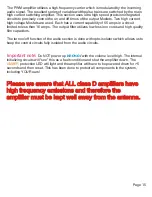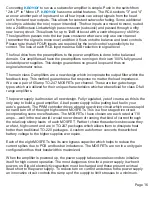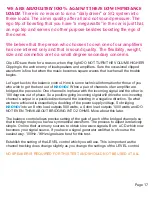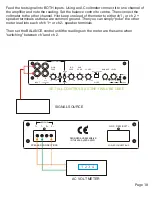
Output level all the time, in fact very rarely. So referring back to the fact that the average
level is about 10-15% of the maximum or peak power of the amplifier, the efficiency is
substantially lower than the 90+%. Typically with a class D amplifier this figure is around
75-85% which is an order of magnitude better than class B amplifiers. This ability of a
class D amplifier makes it a far more viable choice than class B amplifiers for producing
efficient or green (might I say?) amplifiers.
The impedance of the speaker also determines the point at which the efficiency is
optimized. Well as was said on a famous TV show “FOREGETABOUTIT”, this is a pipe
dream. Speaker’s impedance curves are all over the map and too many car audio buffs
love to drive their megawatt class D amplifiers into low impedances, like 1 and 2 ohms.
Well now that I mention “1 ohm”, I cannot resist getting into this subject. Scenario: Kid
buys gizzilion watt amplifier with manufacturer’s specifications of x watts into 4 ohm, y
watts into 2 ohm and z watts into 1 ohm. Well let’s take a wild guess and I bet you all that
the vast majority will drive the amplifier into 1 ohm. Why? Easy, he feels that he is getting
his “moneys worth” by doing this. OK let’s see what reality is. Said amplifier is maybe
rated at say 600w into 4 ohm, 1000w into 2 ohm and 1500w into 1 ohm. We will assume
that the speaker impedance is resistive. The difference between the 4 and 2 ohm power is
2.2dB, the difference between the 2 and 1 ohm power is 1.76dB and the difference
between 4 and 1 ohm power is 3.9dB. So what do these numbers tell us. First if the
speaker is 4 ohms vs 2 ohms, no way you can hear any difference. Same issue
comparing 2 as to 1 ohm. I grant you that between 4 and 1 ohm there is almost 4dB
difference BUT at what price. Two issues. Low impedance loads affect the amplifier’s
sound quality adversely and this is quite easy to prove. Load an amplifier with a 4 ohm
woofer and listen. Add parallel resistors to the speaker to make the amplifier “think” that it
is driving a low impedance speaker and listen to the difference in sound quality. You will
be surprised. This test is not 100% valid in fact as the resistive loads added, let the
amplifier off the hook as the reactive components of the load are confined to the 4 ohm
part. The idea of this test is to keep the loudness about constant but load down the
amplifier.
The average person can just perceive a 3dB (doubling of power) difference and to
actually double the sound pressure on your eardrum, you require TEN TIMES the
amplifier power. Yes TEN TIMES no kidding!
The other consequence of driving amplifiers into these ridiculously low impedances is that
the amplifier is stressed substantially more as compared to when driven into more sane
impedances. Efficiency drops as the losses in the output stages increase dramatically
even with “super efficient” class D amplifiers.
It serves ONLY to boost the ego of the owner of the car so he can quote numbers to his
buddies.
We at Zed are absolutely against these silly loads of less than 4 ohm.
Page 3




















